Yuri Khokhlov
STCON System for the CHiME-8 Challenge
Oct 17, 2024



Abstract:This paper describes the STCON system for the CHiME-8 Challenge Task 1 (DASR) aimed at distant automatic speech transcription and diarization with multiple recording devices. Our main attention was paid to carefully trained and tuned diarization pipeline and speaker counting. This allowed to significantly reduce diarization error rate (DER) and obtain more reliable segments for speech separation and recognition. To improve source separation, we designed a Guided Target speaker Extraction (G-TSE) model and used it in conjunction with the traditional Guided Source Separation (GSS) method. To train various parts of our pipeline, we investigated several data augmentation and generation techniques, which helped us to improve the overall system quality.
LT-LM: a novel non-autoregressive language model for single-shot lattice rescoring
Apr 06, 2021
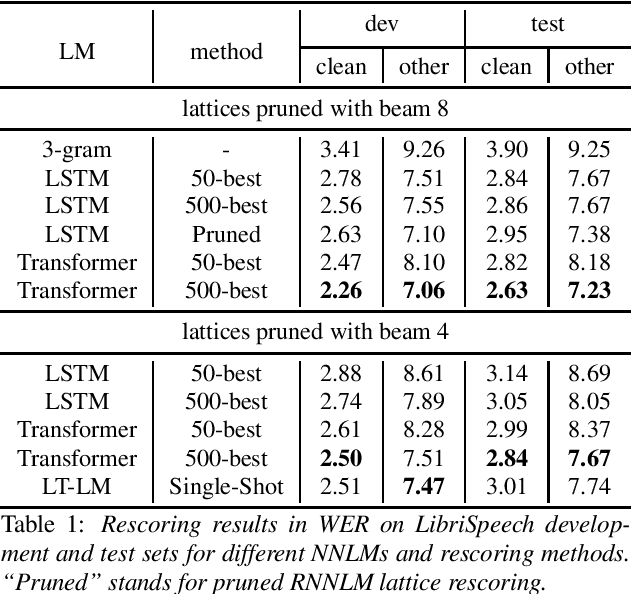
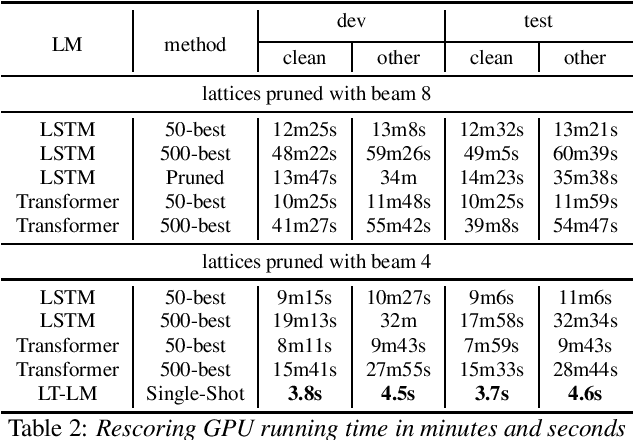
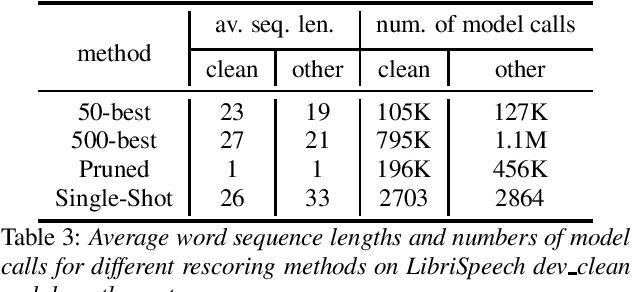
Abstract:Neural network-based language models are commonly used in rescoring approaches to improve the quality of modern automatic speech recognition (ASR) systems. Most of the existing methods are computationally expensive since they use autoregressive language models. We propose a novel rescoring approach, which processes the entire lattice in a single call to the model. The key feature of our rescoring policy is a novel non-autoregressive Lattice Transformer Language Model (LT-LM). This model takes the whole lattice as an input and predicts a new language score for each arc. Additionally, we propose the artificial lattices generation approach to incorporate a large amount of text data in the LT-LM training process. Our single-shot rescoring performs orders of magnitude faster than other rescoring methods in our experiments. It is more than 300 times faster than pruned RNNLM lattice rescoring and N-best rescoring while slightly inferior in terms of WER.
Target-Speaker Voice Activity Detection: a Novel Approach for Multi-Speaker Diarization in a Dinner Party Scenario
May 14, 2020
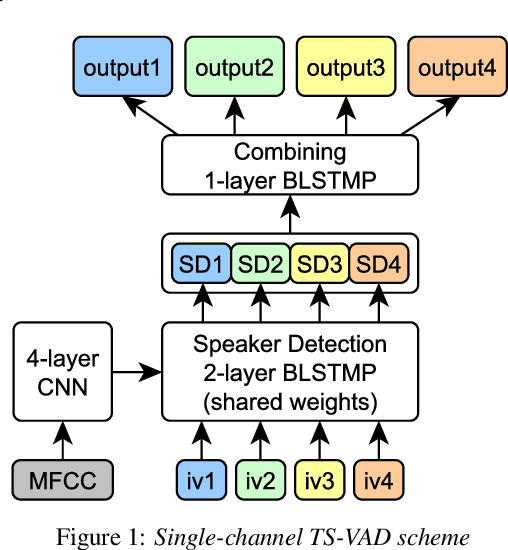
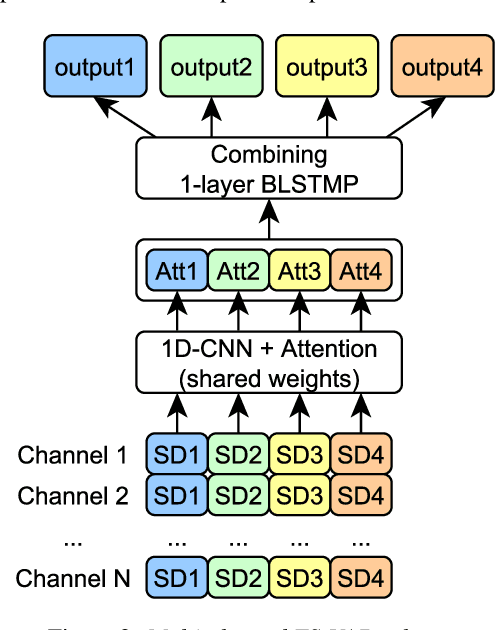
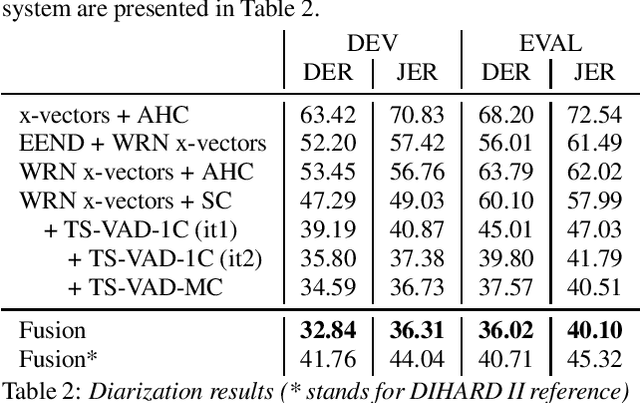
Abstract:Speaker diarization for real-life scenarios is an extremely challenging problem. Widely used clustering-based diarization approaches perform rather poorly in such conditions, mainly due to the limited ability to handle overlapping speech. We propose a novel Target-Speaker Voice Activity Detection (TS-VAD) approach, which directly predicts an activity of each speaker on each time frame. TS-VAD model takes conventional speech features (e.g., MFCC) along with i-vectors for each speaker as inputs. A set of binary classification output layers produces activities of each speaker. I-vectors can be estimated iteratively, starting with a strong clustering-based diarization. We also extend the TS-VAD approach to the multi-microphone case using a simple attention mechanism on top of hidden representations extracted from the single-channel TS-VAD model. Moreover, post-processing strategies for the predicted speaker activity probabilities are investigated. Experiments on the CHiME-6 unsegmented data show that TS-VAD achieves state-of-the-art results outperforming the baseline x-vector-based system by more than 30% Diarization Error Rate (DER) abs.
Exploring Gaussian mixture model framework for speaker adaptation of deep neural network acoustic models
Mar 15, 2020



Abstract:In this paper we investigate the GMM-derived (GMMD) features for adaptation of deep neural network (DNN) acoustic models. The adaptation of the DNN trained on GMMD features is done through the maximum a posteriori (MAP) adaptation of the auxiliary GMM model used for GMMD feature extraction. We explore fusion of the adapted GMMD features with conventional features, such as bottleneck and MFCC features, in two different neural network architectures: DNN and time-delay neural network (TDNN). We analyze and compare different types of adaptation techniques such as i-vectors and feature-space adaptation techniques based on maximum likelihood linear regression (fMLLR) with the proposed adaptation approach, and explore their complementarity using various types of fusion such as feature level, posterior level, lattice level and others in order to discover the best possible way of combination. Experimental results on the TED-LIUM corpus show that the proposed adaptation technique can be effectively integrated into DNN and TDNN setups at different levels and provide additional gain in recognition performance: up to 6% of relative word error rate reduction (WERR) over the strong feature-space adaptation techniques based on maximum likelihood linear regression (fMLLR) speaker adapted DNN baseline, and up to 18% of relative WERR in comparison with a speaker independent (SI) DNN baseline model, trained on conventional features. For TDNN models the proposed approach achieves up to 26% of relative WERR in comparison with a SI baseline, and up 13% in comparison with the model adapted by using i-vectors. The analysis of the adapted GMMD features from various points of view demonstrates their effectiveness at different levels.
Fast and Accurate OOV Decoder on High-Level Features
Jul 19, 2017



Abstract:This work proposes a novel approach to out-of-vocabulary (OOV) keyword search (KWS) task. The proposed approach is based on using high-level features from an automatic speech recognition (ASR) system, so called phoneme posterior based (PPB) features, for decoding. These features are obtained by calculating time-dependent phoneme posterior probabilities from word lattices, followed by their smoothing. For the PPB features we developed a special novel very fast, simple and efficient OOV decoder. Experimental results are presented on the Georgian language from the IARPA Babel Program, which was the test language in the OpenKWS 2016 evaluation campaign. The results show that in terms of maximum term weighted value (MTWV) metric and computational speed, for single ASR systems, the proposed approach significantly outperforms the state-of-the-art approach based on using in-vocabulary proxies for OOV keywords in the indexed database. The comparison of the two OOV KWS approaches on the fusion results of the nine different ASR systems demonstrates that the proposed OOV decoder outperforms the proxy-based approach in terms of MTWV metric given the comparable processing speed. Other important advantages of the OOV decoder include extremely low memory consumption and simplicity of its implementation and parameter optimization.
 Add to Chrome
Add to Chrome Add to Firefox
Add to Firefox Add to Edge
Add to Edge